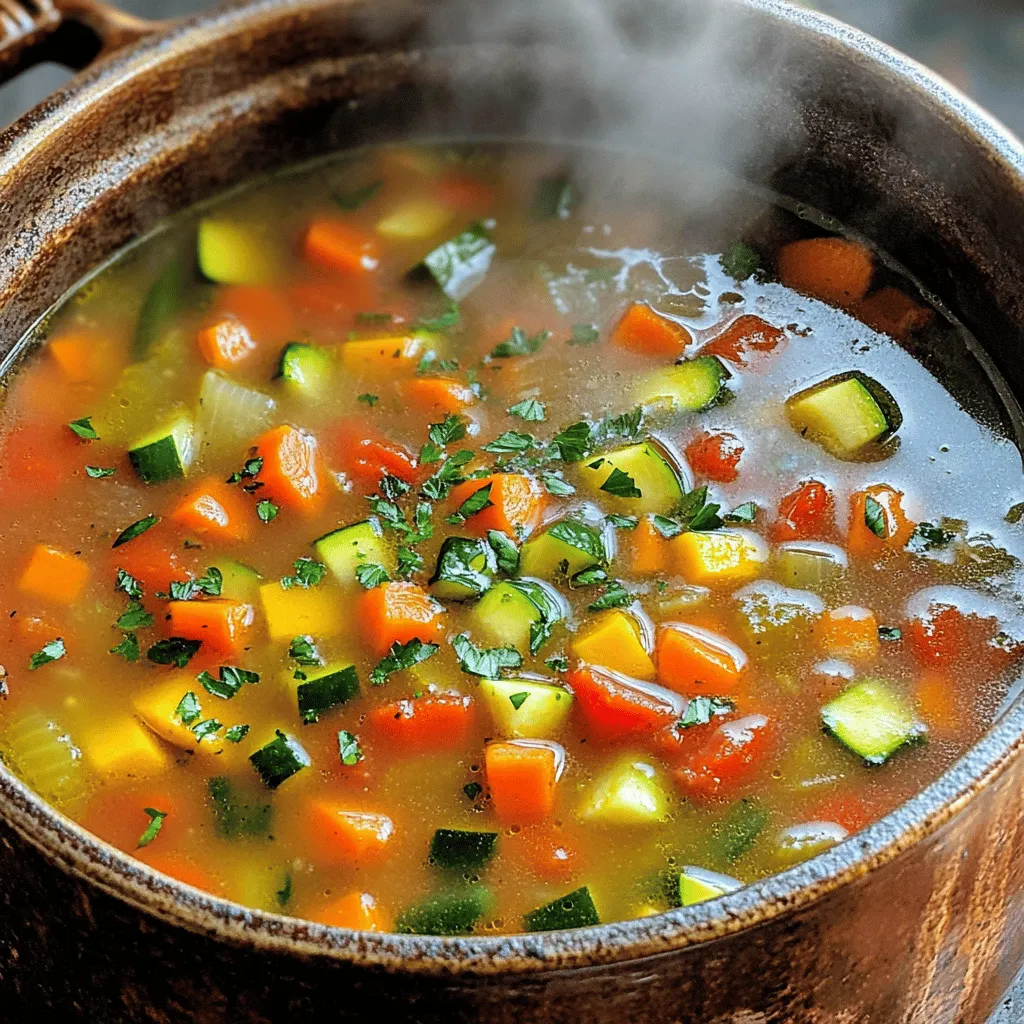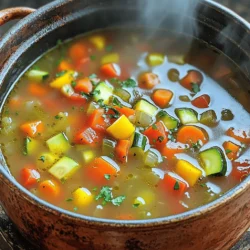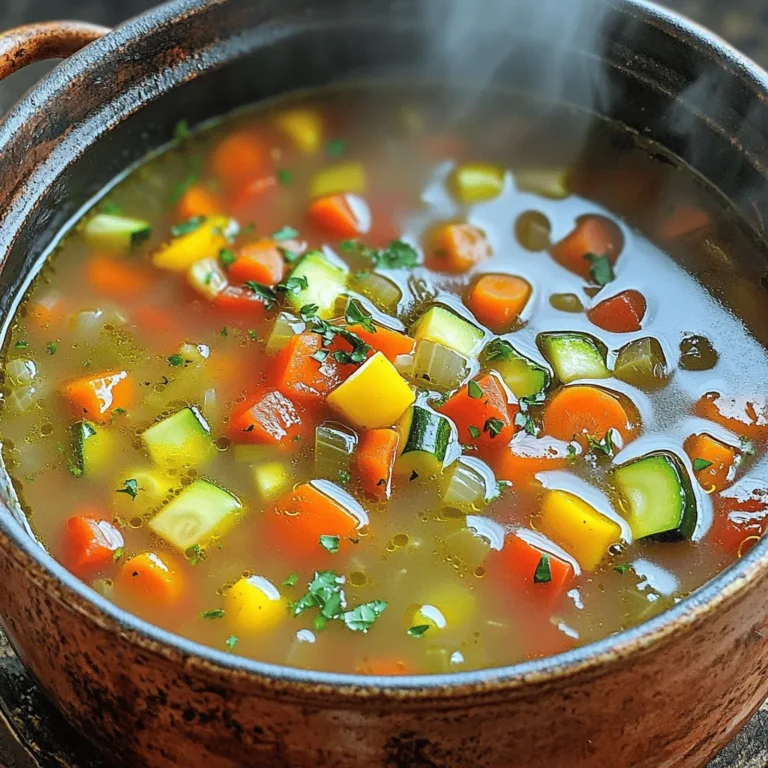Are you ready for a warm, comforting bowl of homemade vegetable soup? This simple and flavorful recipe lets you create a hearty dish packed with fresh ingredients. I’ll guide you through each step, from choosing the best veggies to cooking techniques that bring out amazing flavors. Say goodbye to store-bought soup and hello to a nourishing meal you can make at home. Let’s get started on this delicious adventure together!
Ingredients
Essential Ingredients for Homemade Vegetable Soup
To make a great homemade vegetable soup, you need a few key items. Here’s a list of what you should gather:
– 2 tablespoons extra virgin olive oil
– 1 medium onion, finely chopped
– 2 medium carrots, diced into small cubes
– 2 celery stalks, diced evenly
– 3 cloves of garlic, minced
– 1 medium zucchini, diced
– 1 bell pepper, diced (choose any color)
– 1 cup fresh green beans, trimmed and cut into 1-inch pieces
– 1 can (14 oz) diced tomatoes, including all juices
– 4 cups vegetable broth
– 1 teaspoon dried thyme
– 1 teaspoon dried basil
– 1 bay leaf
– Salt and freshly ground black pepper to taste
– Fresh parsley, chopped, for garnishing
Optional Ingredients for Added Flavor
You can enhance your vegetable soup with extra flavors. Try adding these optional ingredients:
– 1 potato, diced for added heartiness
– 1 cup corn (fresh or frozen) for sweetness
– A splash of lemon juice for brightness
– Spinach or kale for extra greens
– Different herbs like rosemary or oregano for variety
Recommended Tools and Equipment
Having the right tools makes cooking easier. Here’s what you will need:
– A large, heavy-bottomed pot
– A wooden spoon for stirring
– A sharp knife for chopping
– A cutting board for prep
– Measuring cups and spoons for accuracy
– Ladle for serving
With these ingredients and tools, you will create a delicious homemade vegetable soup. Remember, you can always adjust the recipe to fit your taste!
Step-by-Step Instructions
Detailed Cooking Instructions for Vegetable Soup
1. Sauté the Vegetables
Start by heating 2 tablespoons of extra virgin olive oil in a large pot over medium heat. Once the oil is warm, add 1 finely chopped onion. Cook it for about 5 minutes. You want it soft and clear, not brown. Stir it often to achieve this.
2. Add More Veggies
Next, add 2 diced carrots and 2 diced celery stalks. Cook these for another 5 minutes. Stir them well until they start to soften. This mix builds a great base for your soup.
3. Incorporate Garlic
Toss in 3 minced garlic cloves. Cook for just 1 minute. Keep stirring so the garlic doesn’t burn. Burnt garlic tastes bad, so watch it closely!
4. Mix in Zucchini and Peppers
Now, add 1 diced zucchini and 1 diced bell pepper. You can pick any color for fun. Also, add 1 cup of fresh green beans cut into 1-inch pieces. Stir everything well and let it cook for about 3-4 minutes.
5. Combine All Ingredients
Carefully pour in 1 can of diced tomatoes with their juices and 4 cups of vegetable broth. Stir everything together. This step helps blend all the flavors well.
6. Season the Soup
Sprinkle in 1 teaspoon of dried thyme and 1 teaspoon of dried basil. Add 1 bay leaf for more flavor. Season with salt and black pepper to taste. You can adjust this at the end too!
7. Simmer to Perfection
Turn up the heat to get the soup to a gentle simmer. Once it simmers, lower the heat and cover the pot. Let it cook for 20-25 minutes. This time lets the flavors mix nicely.
8. Final Touches
After cooking, take out the bay leaf. Taste your soup and add more salt or pepper if needed. This final step makes the soup just right!
9. Serve and Enjoy
Ladle the hot soup into bowls. Garnish with freshly chopped parsley to add some color and fresh taste. Enjoy this hearty meal!
Tips & Tricks
Cooking Tips for a Flavorful Soup
To make your vegetable soup truly shine, use fresh ingredients. Fresh veggies give a vibrant taste. Start by sautéing the onion in olive oil. This builds a solid flavor base. Cook it until soft and translucent. It should take about five minutes. Next, add your carrots and celery. These veggies add sweetness and crunch. Don’t rush this step; let them soften. Then, mix in garlic for a fragrant kick. It only needs a minute. Stir often to avoid burning.
Common Mistakes to Avoid
One common mistake is overcooking the vegetables. You want them tender, not mushy. Adding salt too early can draw out moisture. Wait until the soup is nearly done. Another mistake is skipping the bay leaf. It adds a depth of flavor you don’t want to miss. Lastly, don’t forget to taste your soup. Adjust the seasoning as needed before serving.
Best Practices for Adjusting Seasoning
When it comes to seasoning, start small. Add a little salt and pepper, then taste. You can always add more, but it’s hard to fix a salty soup. Fresh herbs at the end can brighten the dish. Parsley, for example, adds color and freshness. If your soup tastes flat, a splash of lemon juice can help. It adds brightness and lifts the flavors. For a richer taste, try a sprinkle of grated cheese on top.

Variations
Creative Variations on Vegetable Soup
You can change vegetable soup in many ways. Try adding different herbs for extra taste. Fresh dill or cilantro can give a bright flavor. You can also add a splash of lemon juice for some zing. If you love spice, consider adding red pepper flakes or a dash of hot sauce. For a creamy texture, blend part of the soup before serving. This gives it a smooth and rich feel.
Seasonal Vegetable Options
Use seasonal veggies for the best flavor. In spring, add fresh asparagus or peas. Summer is perfect for ripe tomatoes and corn. In fall, try sweet potatoes or butternut squash. Winter brings hearty root vegetables like parsnips and turnips. Each season offers unique tastes. Changing the vegetables keeps the soup exciting and fresh.
Protein Additions for a Heartier Meal
To make the soup more filling, add protein. Canned beans like chickpeas or kidney beans work well. You can also add lentils for a healthy boost. If you eat meat, shredded chicken or diced ham can add flavor. For a vegetarian option, tofu is a great choice. Adding protein makes the soup a complete meal.
Storage Info
How to Store Leftover Vegetable Soup
Storing leftover vegetable soup is easy. Let the soup cool down to room temperature first. Then, pour it into airtight containers. Make sure to leave some space at the top, as liquids expand when frozen. Store it in the fridge if you plan to eat it within a few days. Otherwise, freezing is your best option.
Freezing Instructions for Long-Term Storage
To freeze your soup, use freezer-safe containers or heavy-duty freezer bags. Label them with the date and contents to avoid mix-ups. Vegetable soup can last up to three months in the freezer. When you’re ready to use it, simply thaw it in the fridge overnight. This keeps the flavors fresh and tasty.
Reheating Tips to Preserve Flavor
Reheating your soup is simple. For the best taste, use the stove. Pour the soup into a pot and heat it over medium-low heat. Stir it often to prevent sticking. You can also use a microwave. Just heat it in short bursts, stirring in between. Add a splash of water or broth if it seems too thick. Enjoy your warm and flavorful soup!
FAQs
What is the best way to make vegetable soup from scratch?
The best way to make vegetable soup is to start with fresh ingredients. I love using a mix of vegetables like carrots, celery, and zucchini. First, sauté the onions in olive oil until they are soft. Then add the other veggies and cook them down. Don’t forget to add garlic for flavor. Next, pour in vegetable broth and diced tomatoes. Let it simmer to blend the flavors. This method makes a rich and tasty soup.
Can I use frozen vegetables in homemade vegetable soup?
Yes, you can use frozen vegetables in your soup. They are a great option when fresh veggies aren’t available. Frozen veggies can save you time, too. Just add them straight to the pot after sautéing the onions. They will cook down nicely as the soup simmers. Keep in mind that frozen vegetables may cook faster than fresh ones. So, adjust the cooking time as needed.
How long does homemade vegetable soup last in the fridge?
Homemade vegetable soup can last about 3 to 5 days in the fridge. Be sure to store it in an airtight container to keep it fresh. If you want to keep it longer, freezing is a great option. Just freeze it in portions. That way, you can enjoy it later without losing flavor.
Is homemade vegetable soup healthy?
Yes, homemade vegetable soup is very healthy. It is packed with vitamins and minerals from all the vegetables. Plus, you control the ingredients, which means you can avoid extra sodium and preservatives. The soup is also low in calories, making it a great choice for a light meal. Enjoy it guilt-free!
Homemade vegetable soup is simple and delicious. You need fresh ingredients and the right tools. Following my step-by-step guide helps you make a flavorful soup. Use my cooking tips to avoid common mistakes. Try different variations with seasonal veggies or protein for variety. Store leftovers properly to enjoy later. Making soup from scratch is not only easy, but it’s also healthy. Enjoy the warmth and comfort of your creation.


